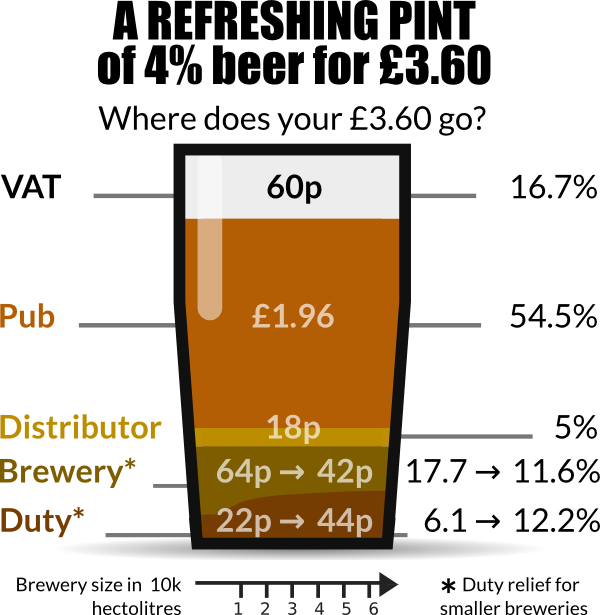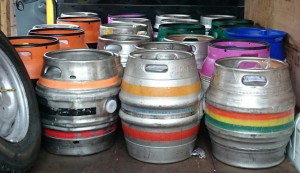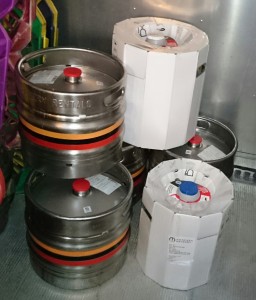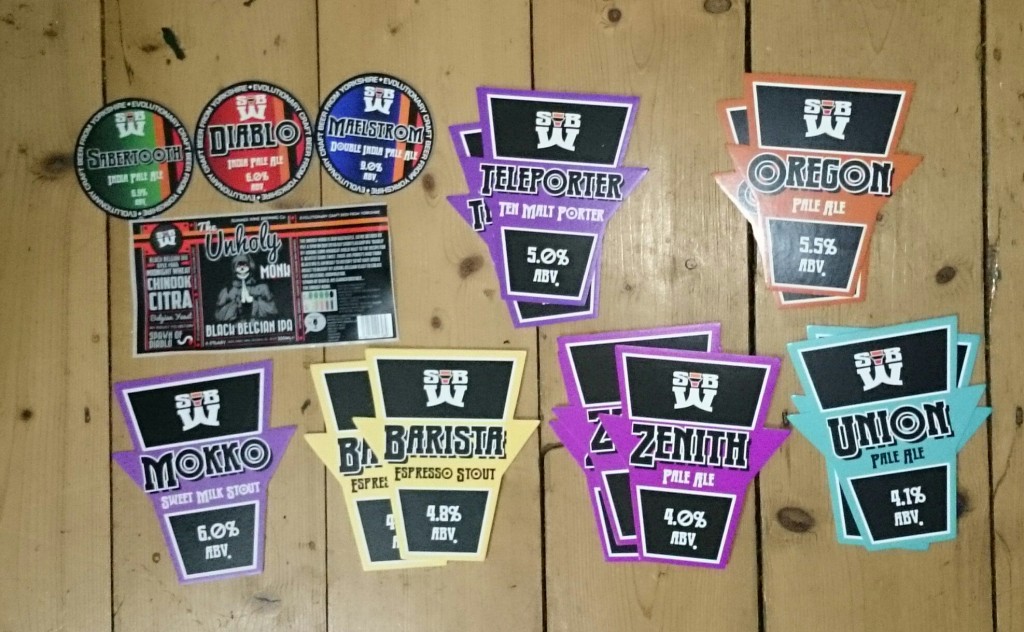EDIT: 2014-05-03: I have adjusted the figures in this post to not use the minimum GP I’ve been applying to beers but something more normal/average – I’ve moved it from 11.11% to 17.24% but I’ve been told I ought to be targeting 20%. As I stated I’ve seen margins spanning from as low as £5 to £15 out there and I sort of went for the middle to start with (since I’m not in London). I’m a newbie at this… on a steep learning curve.
Inspired by my new reality of being piggy-in-the-middle between pub and brewery beer pricing I’ve knocked up the following “infographic”… OK, it has minimal “info” and my “graphic” skills are suspect at best, Kat has drawn me a prettier version of the infographic now! But here we are, where does the hard earned money that you spend on a pint of beer go:
I have clumsily tried to show the progressive beer duty here, in steps from the full relief rate through 10k, 20k, 30k, 40k, 50k hectolitre breweries to the full rate on the right. (In reality this is a gradual increase dependant on brewery production – not stepped.) These figures are based on a 4% beer and as both the price of the pint and the duty will vary with the strength one could generate a variety of different versions of the above – however I believe the general gist of the ratios shown for my “£3.60 4% bitter in Cambridge” example will hold across a broad area and range of beers.
Of course if there is a PubCo involved then there’s a massive chunk missing from this that takes a big bite out of the “pub” section. Probably up to 50% of it based on the pricing I’ve heard from tied publicans I know. (Which makes me all the more perplexed by free-houses who pop a vein over £5.)
The format of this is inspired by Yeastie Boys Stu’s lower-tech but far more characterful infographic shown here: What’s in my beer? Stu breaks it down further than I have, although remember he’s in New Zealand and his breakdown is focused more on the bottle market so is rather different to the UK situation. Freight costs in my case are part of the brewery’s costs in getting beer to me and part of my costs in returning empties to them, it can get more complex in the case of using eCasks too. Each of the “brewery”, “distributor”, and “pub” sections could be broken down further in similar ways. Everyone needs to rent/maintain facilities, pay for consumables, pay staff, etc. In fact Dave Bailey of Hardknott fame has contributed this level of detail from the brewer’s point of view to the Guardian: Beer: how much would you pay? I don’t think I’ve seen a breakdown for pubs but I expect high rents and high wage bills to consume a large chunk of their share.
The “distributor” chunk is based on a mere £7.50 £12.50 margin on a cask – which is what I’m using in many (but not all) cases. This varies though – and the highest average margin I’ve seen is £15 down in London. But the retail prices are higher at the pump in London too, so the higher margin probably doesn’t change the total percent taken by the distributor. (Not to mention that the costs of operating in London must be even higher than Cambridge!)
Why did I put all this together? Mainly to show the “distributor” band there. That’s my bit… and when some landlord dismissively tells me “you need to sharpen your pencil“, this is why I’m inclined to tell him to go bugger himself. Of course I wouldn’t say that … even in the face of rudeness… sorry, I say, I don’t think we can help each other. The only way I can offer lower prices is by buying cheaper beer. As it stands I’ve moved my minimum margin from 3% to being closer to a whopping 5% of your pint… or 18p of your £3.60. Reducing the publican take to a meagre £1.96 from £2.04. Eyebrows will be raised. [2014-05-03: Numbers modified slightly. Originally the numbers and graphic were based on the lowest margin I’ve used -£7.50 per cask (3% of retail value). This is too low… bear with me, I’m new to this. Also, to avoid confusion: the 5% is of the retail cost of the pint and represents a GP to me of about 17.25%.]
Don’t take this as a negative post, my customer base is building and I’ll continue to try and do what I desire to do… bring different and interesting beer into my area. I’m not trying to rip anyone off, I cannot “sharpen my pencil” as I’m only working with a stub of charcoal here. If you’re interested in beer and beer excites you then I think I have something to offer… in effect I work for you to get hold of the beers that the national beer scene is talking about, enjoying, and wanting to get their hands on. I have a fairly broad coverage from what’s hot in CAMRA/traditional circles to what’s turning heads amongst craft beer junkies. I feel I’ve come to know the UK beer scene pretty well at several levels and all I really want to do is spread the love. But… if beer is a replaceable commodity of no individual character or value to you then I’m afraid we aren’t going to get along.
Finally – I’m a big believer in “openness”, I have hippy commie open-source roots, I’ve spoken of many variables in the text around the infographic… so, here’s my little spreadsheet: Who gets what from your beer money? You can duplicate this and play with the numbers as you like… or spot the errors in my calculations? (If so then please let me know!) Cheers to Geoff Latham of Pope’s Yard brewery for eye-balling my spreadsheet for me – however I do take full responsibility for any errors that snuck through of course!
Know any pubs in the Cambs/Herts/Beds area that you’d like to have some of my beers at? (Yes, I need to update that list…) Think they’re the run by the sort of people who’re not after the cheapest thing on the market? Point them my way… or point me their way… :)
[Edit: 2014-05-03: People have pointed out that this might make the pubs look “greedy”. This is not the intention at all! Yes pubs have a high GP, but they have huge costs as well. There are some numbers on the costs of running a pub available at the link provided by Jon in the comments. It is also worth noting that for a pub a mere 5p lost on a pint isn’t completely trivial… say a pub shifts 500 firkins of beer a year, 35000 pints… £1750 lost profit. And that’s a small pub. My thinking is that in the right pubs with the right customers that 5p cost can be passed on to these beer-loving customers who are willing to pay it for a better beer and better beer variety. Not all 4% beers are made equal so why should they all be priced equally? More on this another time…]





Jolly good. As it happens, the BBPA do some cost breakdowns for the running of the pub over here
Thanks for that Jon. If I have time I’ll try to do a refined version of the diagramme with exploded out sections for pubs and brewers. Well, some averaged approximation of them at any rate. I guess I can work off Dave’s figures for the brewer bit.
Although I should probably coax Kat into doing the graphics so they’ll be less ugly.
Is this your GP or NP?
All the numbers represent GP.
Your GP on that one example is fraction over 11%, not 3%.
Ah, sorry, I misunderstood. Yes – the 60+7.50 GP is 11.1…%. The numbers in the post represent % of the final retail value of the beer. I.e. 7.50/(3.60*70)=~2.976%
The GP in this case is, IMO, too low… but I’m in a place between trying to bootstrap a customer-base and get the word out there in a market where >£65 for a firkin is looked at at trying to rip people off.
Pingback: News, Nuggets and Longreads 03/05/2014
Pingback: Gross Profit – why £6 is a good price for a pint of Gamma Ray | ALE.is.GooD